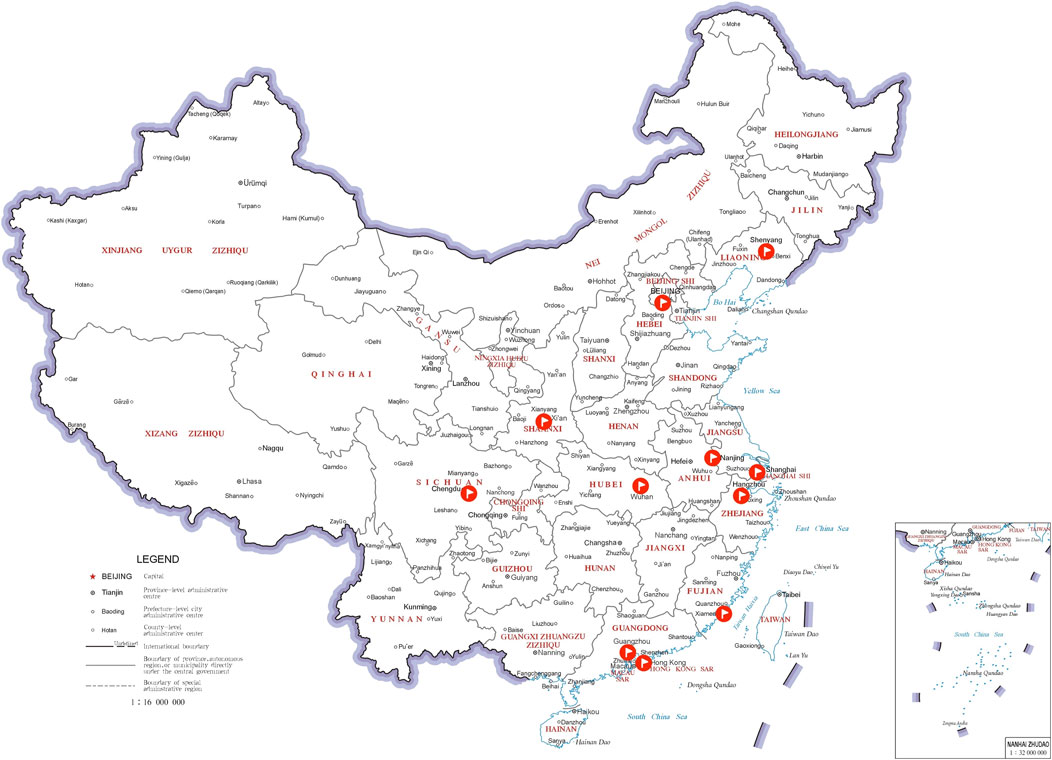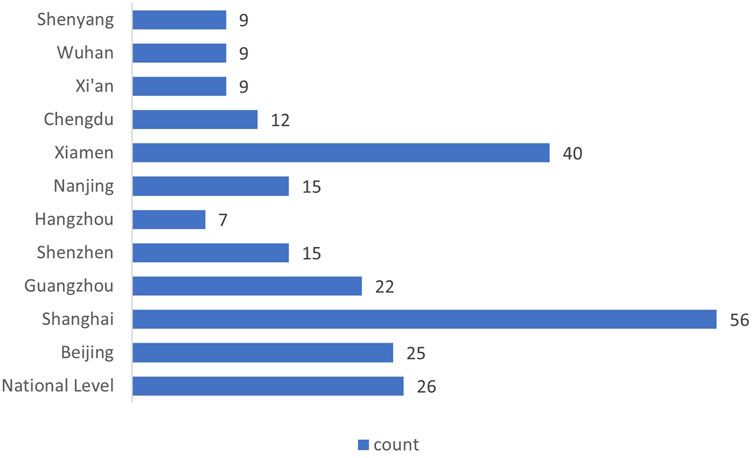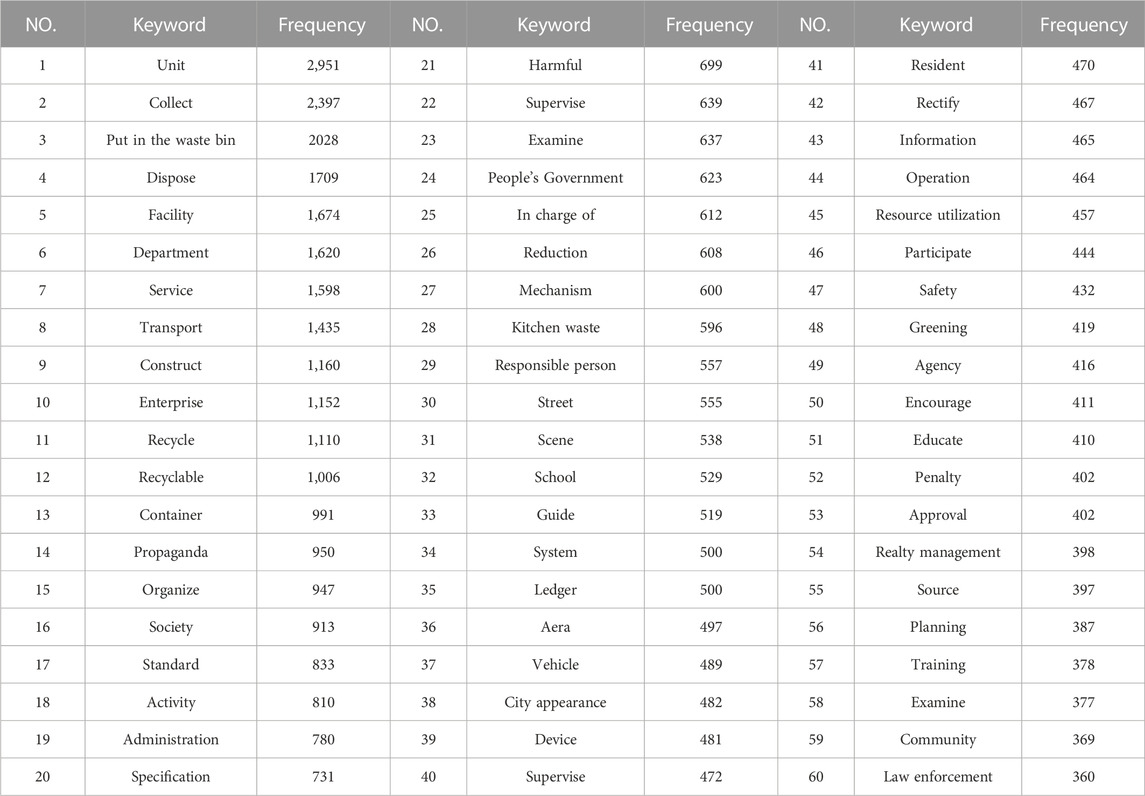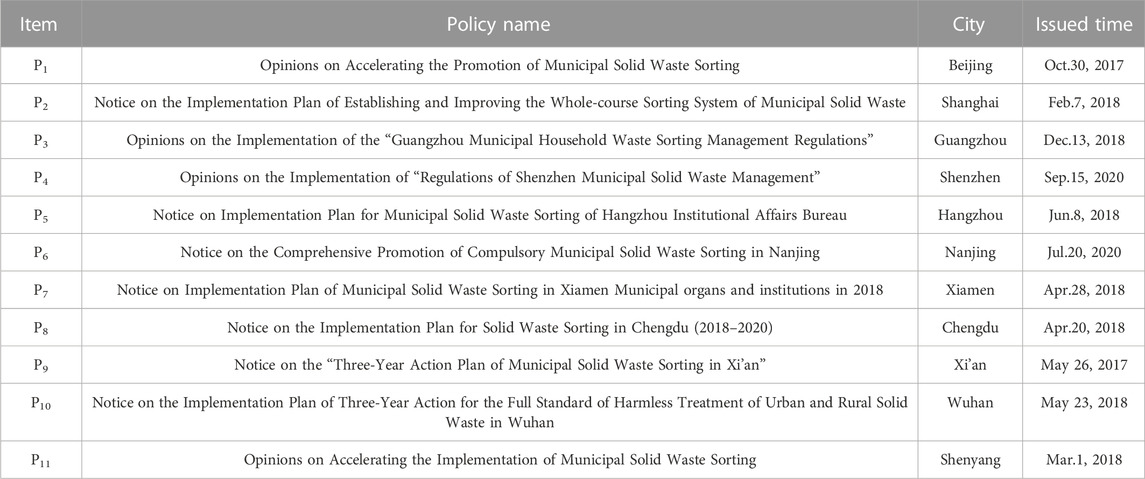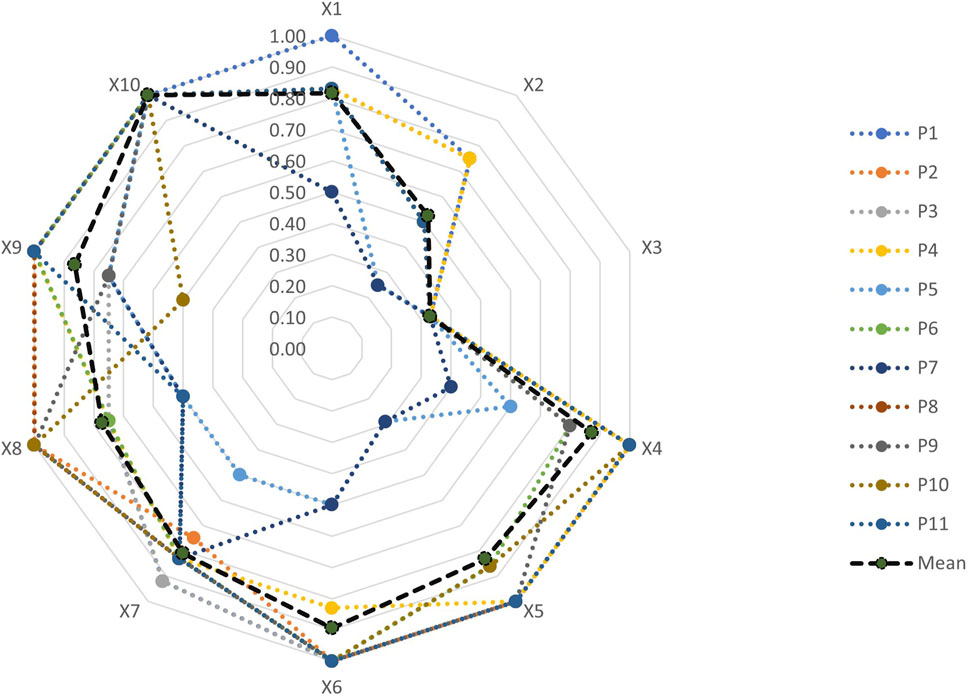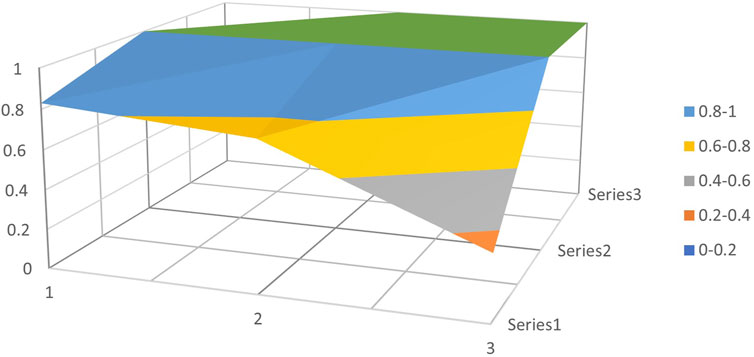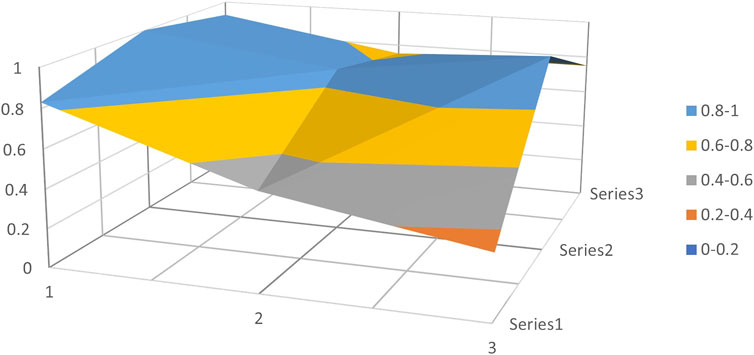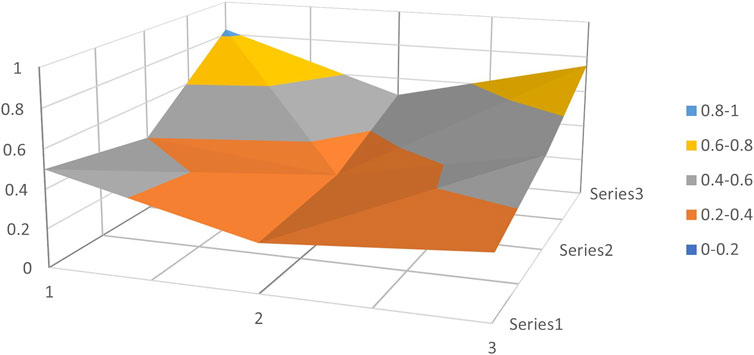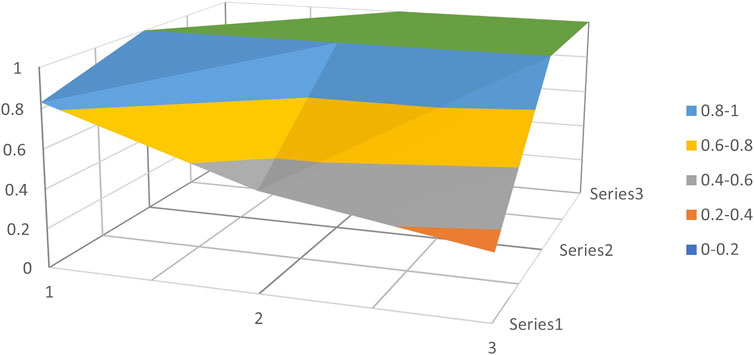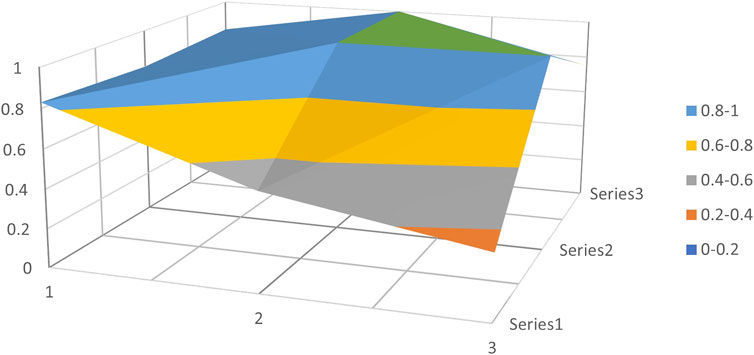- 1College of Management and Economics, Tianjin University, Tianjin, China
- 2School of Public Administration, Hainan University, Haikou, China
Municipal Solid Waste governance in China entered a new phase in March 2017 when the Chinese government began requiring major cities to enforce waste sorting as well as to develop a system of laws, regulations, and standards regarding waste sorting. This study used text mining and the Policy Modeling Consistency (PMC) Index model to develop an evaluation system of Municipal Solid Waste sorting management policies that included 10 first-level variables and 51 second-level variables to quantitatively evaluate the texts of waste sorting management policies in 11 major cities, and then the PMC surface of policy texts was constructed to analyze the strengths and weaknesses of individual policies according to the PMC index values. The results revealed that there were no excellent level or bad level policies among the 11 policies, with an average PMC index value of 7.71. Overall, the 11 policy texts all set out clear goals and programs in accordance with local conditions, but there are some differences across policies in terms of indicators, including policy content, policy function, policy evaluation, restriction and incentives. This study provides a fresh viewpoint on the policy evaluation of waste sorting management and offers some insight for policymakers, who should pay attention to waste separation, focus on key indicators of the policy, and enhance the effectiveness of the policy response. In addition, the applicability of the evaluation model and the difficulties associated with waste sorting governance of China in post-epidemic are discussed.
1 Introduction
Municipal Solid Waste (MSW) Management has emerged as one of the most severe environmental governance challenges affecting governments worldwide. Developed nations have built a relatively sound MSW management system after decades of governance (Tong et al., 2020). For instance, Japan, a developed country with a similar geographical location and composition of household waste to China, has established standards for waste sorting, detailing the treatment of different kinds of waste. Since the implementation of waste sorting, Japan’s MSW generation has decreased by 21.8% between 2000 and 2017 from 54.83 to 42.89 million tons, end-of-pipe disposal has decreased from 10.51 to 3.86 million tons, and the rate of resource recovery has increased from 14.3% to 20.2% in 2017. Japan’s MSW management has entered the era of recycling (Zhong and Zhong, 2020). In Europe, The E.U. Waste Framework Directive (2008/98/E.C.) specified the hierarchy of waste management: Prevention, Re-use, Recycling, Recovery, and Safe Disposal, while also clarified the “polluter pays principle” (European Commission, 2008). In 2018, the European Parliament and the Council of the European Union adopted amendments to the Waste Framework Directive requiring member states to comply with the obligation to separate and collect waste according to the Waste Framework Directive, renewable energy subsidies for waste incineration should be removed if they fail to comply. The goal of halving the amount of residual (non-recyclable) municipal waste by 2030 was subsequently proposed (European Commission, 2020). Separating waste at the source to reduce waste generation has become the worldwide consensus for MSW management.
China has experienced significant economic growth for over 40 years as the world’s largest developing nation following reform and opening up, the amount of solid waste produced in 2004 ranked first globally as a result of urbanization and greater living standards (Kaza et al., 2018). According to data from the Ministry of Ecology and Environment’s (formerly the Ministry of Environmental Protection) Annual Report on the Prevention and Control of Solid Waste Pollution and Environment in Large and Medium-sized Cities in China, MSW in China’s large and medium-sized cities increased from 168.2 million tons in 2014 to 235.6 million tons in 2019, with an average annual growth rate of more than 8 percent (Ministry of Ecology and Environment of the People’s Republic of China, 2018). From World Bank’s estimate, China’s MSW production will top 300 million tons by 2030 (Kaza et al., 2018), severely impacting large cities’ waste management.
In the past, China mainly used landfills to dispose of waste, which caused a large amount of land resources, and improper disposal will cause irreversible damage to land and groundwater and even endanger human health. Cities were facing the dilemma of “waste siege.” With the promotion of waste incineration technology, waste incineration has gradually become the dominant waste treatment method in China, with the incineration rate of MSW reaching 62.29% in 2020 (Ministry of Housing and Urban-Rural Development of the People’s Republic of China, 2021). Meanwhile, China has started to shift waste management from terminal treatment to source reduction and resource recovery, and a pilot project called “waste-free city” has been started in China to cut down on the amount of solid waste at the source (Li et al., 2022a). Waste sorting is a comprehensive management system involving multiple subjects such as government, residents, enterprises, social organizations, etc., including waste placement, collection, transportation, disposal, and recycling (Ma and Hipel, 2016). The policies and regulations of MSW sorting management (MSWSM) not only guarantee the successful implementation of MSW sorting by government agencies, but also give waste separate guidelines to the general people.
Policy evaluation is a highly essential aspect of the public policy analysis process, which is the basis for reasonable classification and allocation of policy resources and an effective way of testing the effects of policies (Yang et al., 2021a). The Chinese government regularly uses pilot projects to verify the impacts of policy implementation and provide experimental benchmarks for wider implementation (Zhang and Wang, 2020). In fact, rising international research on the evaluation of waste sorting management policies has started to emerge due to the gap between the policy implementation impacts and the intended policy goals. However, A large body of literature evaluates MSWSM policies at the macro level, and few evaluate the strengths and weaknesses of individual policies. For example, (Xiao et al., 2020) reviewed the model and current status of waste sorting in Shanghai, China, and positively evaluated the models of mandatory waste separation legislation, green account program, and joint network program in Shanghai. Bergeron (Bergeron, 2020) integrated the Geneva waste management policy with the categorization management practice from 2002 to 2013, performed a SWOT analysis of the strengths, weaknesses, opportunities, and threats of Geneva waste management, and confirmed the efficacy of the Geneva waste management policy. Daskal et al. (2018) analyzed the policy and current situation of waste management in Israel, the significance of municipal solid waste regulations was highlighted by practical statistics such as classification, recycling, and landfilling. Moh and Abd Manaf (2017) discussed the waste management policies and plans transformation in Malaysia from a historical perspective, and analyzed the issues of MSW management, including public responsibility and stakeholders. Therefore, this paper tries to bridge the gap from the perspective of Chinese cases. Firstly, MSWSM policies in China are exploited using text extraction techniques to summarize and describe existing policies; Secondly, a PMC Index model is created to provide a quantitative evaluation framework for MSWSM policies research in China’s Major Cities; Finally, the MSWSM policy texts from 11 cities are selected as research samples, and the policy contents are quantified and assigned, then the policy is analyzed in depth based on the results of the evaluation.
2 Literature review
2.1 Analysis and evaluation of China’s MSWSM policies
A hot topic of research in the field of waste management has been the analysis and evaluation of waste management policies. The policy text is a physical vehicle for illuminating the “black box” of government policymaking, with the function of information transmission and communication, reflecting the value orientation of policymakers and providing a window for researchers to observe the policy process (Ren et al., 2017). Content analysis is a common method of analyzing public policy. Zheng and Chen, 2021) analyzed the content structure of the municipal policy text on mandatory waste sorting, using institutional jurisprudence tools under the IAD (Institutional Analysis and Development) analytical framework, and summarized the functional contours and institutional features of the MSWSM policies. Tian (Tian, 2015) used word frequency analysis and textual analysis to analyze trends in policy objectives, policy objects, policy instruments, and policy values in China’s MSWSM policies over the last decade. Wan and Wang (Wan and Wang, 2020) developed a policy expression model to explain the historical evolution of MSWSM in China through these changes in policy philosophy, policy structure, and policy process. From a time-series perspective, Tan et al. (2021) examined the evolution of stage characteristics and governance paths of MSWSM in China based on social network and cluster analysis methods.
Other scholars examine China’s MSWSM policy from the point of view of policy instruments. Xie and Xu (2021) and Sun et al. (2021) present a three-dimensional and two-dimensional framework for MSWSM policy analysis, respectively, based on policy instrument theory, and both conclude there are currently too many environmental policy instruments and not enough supply-based and demand-based options. Tian (2020) argues that the applicability of coercive tools in waste sorting is determined by two sets of variables. Local government capacity is a prerequisite for “coercion”; when the policy network is inappropriate, policy marketing can reduce resistance from the policy network and make “coercive sorting” feasible. Contrary to Xie et al. and Sun et al., He et al. (He et al., 2017) believe that policy tools such as regulation-typed tools, market-typed tools, and public participation-typed tools complement each other very well. Also, He et al. constructed a three-dimensional analytical framework to examine the problem of coordination in MSW policy making, and found that there was little coordination between policy levels and policy subjects due to “fragmented authoritarianism,” which produces inter-ministerial competition, impedes coordination between policy departments. Likewise, Wang and Jiang (2020) investigated the Chinese legislation for MSWSM from the viewpoint of Authoritarian Environmentalism and found that the government dominates waste management in China, the unbalanced distribution of local legislation, and localism may threaten the results of authoritarian environmentalism.
Public attitude and support are crucial to the implementation of MSWSM policies. Wan et al. (2018) conducted a study of Hong Kong residents by telephone that found large differences in support for different MSW policies according to gender, age, and educational level, and that household size and political orientation had little influence. Respondents expressed more support for policies to develop recycling industries and producer responsibility programs, and less support for policies to charge for waste and promote education. Chen et al. (2018) present the opposite perspective based on research conducted in Nanjing, finding that household size is the most significant determining factor of support for waste sorting, and with 52% of the population supporting mandatory waste sorting. Hou et al. and Wu et al. used web crawlers, a data mining technique, to perform sentiment analysis on web data of MSWSM policies. Hou et al. (Hou et al., 2020) found that public support for strict waste sorting policies was low in the beginning and became increasingly lower over time, the primary reason for that being trouble. On the contrary, the public showed more positive willingness and support for flexible waste sorting policies. Wu et al. (Wu et al., 2021) found that nearly half of the Chinese public did not support MSWSM policies and that people living in economically developed regions were more concerned about MSW sorting. He also noted that public concerns shifted from how to sort and penalties related to improper sorting at the beginning of policy implementation to the cost, time, and irregularities of the recycling process after a period of implementation. Other researchers have compared the waste sorting policies and MSW management systems of different countries, regions, and cities (Guerrero et al., 2013; Fan et al., 2019; Chand Malav et al., 2020; Kurniawan et al., 2021), which provides a framework for exploring the governance path of MSW in China. Furthermore, methods such as fuzzy set theory (Wan and Wan, 2020), SWOT analysis (Zhou et al., 2019), Bayesian theory (Yang et al., 2018a), DEA model (Yang et al., 2018b), and system dynamics method (Li and Wang, 2021), etc., have been employed to analyze and evaluate MSW policies and MSW management systems in China.
2.2 Impact of MSWSM policies
In terms of the impact of waste sorting policies, Chen et al. (Chen et al., 2018) found through a study of Nanjing communities that mandatory waste sorting policies increased waste separation by 49.7%, the investments in source-separated facilities, publicity, and special monitoring have substantial positive benefits on MSW source-separated collection. In an analysis of panel data from eight pilot cities for waste sorting, Han et al. (Han and Zhang, 2015) concluded that MSWSM policies had little effect on the reduction of MSW per capita, and that consumption levels, household size, and education levels significantly accelerated MSW per capita generation. Han et al. (Han et al., 2016) examined the crowding-out effects of MSW policies and concluded that fees and source separation had a crowding-out effect on voluntary source separation, waste fees decreased intrinsic motivation for resource separation, incentives performed as weak enhancers in the short run and negative enhancers in the long run, and the crowding-out effects of mandatory and voluntary policies on waste generation must be considered. Through quasi-natural experiments and questionnaires, Yang et al. (Yang et al., 2021b) investigated the spillover effects of various waste sorting policies on sustainable consumption behavior and found that punishment policies substantially reduced sustainable consumption behavior while voluntary participation policies substantially increased sustainable consumption behavior. Xu et al. (Xu et al., 2018) examined the spillover effects of MSWSM policies on other environmental behaviors, such as household electricity conservation in Hangzhou. Chen et al. (Chen et al., 2021a) examined the impact of MSWSM policies on the green industry, and they identified that investors were insensitive to the introduction of MSW sorting in the short term, financial restrictions, insufficient incentives, and ineffective incentives did not benefit the waste sorting industry, and that additional measures were needed to remove uncertainty in the municipal waste sorting industry.
In general, the literature reviewed above provides support for the improvement and optimization of MSWSM policies and MSW governance in China. Nevertheless, most evaluations and analyses take a macroscopically focused approach to identify the issues with overall policies, and they seldom evaluate individual policies separately. With a view to remedying the limitations of previous studies, this study provides a micro perspective in order to evaluate the strengths and weaknesses of individual policies to provide a reference for optimizing MSW governance in government. In addition, this study develops a systematic PMC index model for MSWSM policy evaluation, which enriches the method of environmental policy evaluation and enhances its scientificity.
The PMC (Policy modeling consistency) index model is a new model proposed by Estrada in 2010 for policy modeling evaluation (Ruiz Estrada, 2011; Estrada and Arturo, 2022). It is based on the “Omnia Mobilis” notion that everything in the world is in motion and that while modeling, all important variables should be taken into account as much as possible and not overlooked (Ruiz Estrada et al., 2022). Comparatively to other policy evaluation methods, the variables of the PMC index model, especially the second-level variables, are mostly derived from policy text mining, which reduces the subjectivity of the evaluation. It also provides a scientific and effective basis for policy improvement by quantifying the level of internal consistency in policy modeling and by identifying the strengths and weaknesses of policies from multiple perspectives. This model has been used in many areas, including new energy vehicle (Yang et al., 2021a), cultivated land protection (Kuang et al., 2020), green development (Dai et al., 2021), employment recruitment (Chen et al., 2021b), ecological compensation (Li et al., 2022b; Dai et al., 2022), carbon emission reduction (Zhao and Tang, 2018) and pork industry (Li et al., 2021),etc. The model has been modified and improved by some researchers in response to the characteristics and attributes of various categories of public policies being evaluated, thereby enabling the model to contribute to a more mature methodological system, which further verifies the scientific validity and applicability of the PMC index model. Therefore, this paper attempts to compensate for the lack of evaluation of existing waste sorting policies by quantitatively evaluating MSWSM policies using the PMC Index model.
3 Research design and methods
3.1 Overall of China’s MSW policies
In response to the waste management challenge, China started its exploration of MSW management regulations in the 1980s. In 1986, the State Council forwarded “The report on the treatment of urban waste to improve the appearance of environmental sanitation” from the Ministry of Urban and Rural Environmental Protection and Central Patriotic Public health Campaign Committee, which was the beginning of MSW management in China (Tian, 2015). The “Measures for the Management of Municipal Solid Waste” issued in 1993 was the first particular management measure in the field of municipal solid waste. In 2000, the Ministry of Construction designated eight cities, including Beijing, Shanghai, Guangzhou, Shenzhen, Nanjing, Hangzhou, Xiamen, and Guilin, to conduct pilot MSW sorting. However, pilot cities did not perform well due to a lack of waste separation and treatment facilities and inadequate public participation (Lu and Sidortsov, 2019). Subsequently, China’s MSW regulations and policies focus on the development of technical standards for waste treatment, the establishment of a waste charging system and the industrialization of waste treatment, etc. The waste sorting pilot project, technological innovation, market-oriented reform, educational propaganda, and the involvement of social forces are at the heart of China’s MSW management policies.
In March 2017, the State Council forwarded “The Implementation Plan of the MSW Sorting System,” which stipulates the implementation of obligatory MSW sorting in 46 key cities throughout the nation. The plan stipulates that the MSW recycling rate will reach 35% by 2020. The policy that was later released clarifies the goal of building a separate collection and transportation system for MSW in 46 key cities by 2023. China’s MSW management is a continuous governance action. We gathered data from Beida Fabao (http://www.pkulwaw.com), a comprehensive collection of Chinese law and policy, and supplemented it with information from the websites of all levels of government departments. Provincial and urban local governments issued over 3,000 MSW policies until April 2022, of which over 1,450 were issued after March 2017. As shown in Figure 1, state and local MSW policies and bylaws have increased from 129 in 2016 to 251 in 2017, and have remained high over the past 3 years. MSW sorting activities have been launched nationally, and the topic of waste sorting has made headlines in newspapers and social media. China has embarked on a new phase of mandatory waste sorting.
3.2 Data sources
National MSWSM policies of China must be taken into account because the State Council and central ministries and commissions’ rules and regulations are extremely authoritative and universal, and serve as a guide for local governments in provinces and cities to formulate localized policies. This paper draws on a variety of policy texts issued by the Communist Party of China (CPC) Central Committee, the People’s Congress, the State Council, the Ministry of Ecology and Environment, the Ministry of Housing and Urban-Rural Development, the National Development and Reform Commission, the Ministry of Education, and other national-level agencies.
China is a large and populous nation. Climate, geography, economy, and way of life differ drastically between provinces and cities. Consequently, it is vital to examine the MSWSM policies in various geographic regions. China is divided into seven primary geographic regions according to the comprehensive geo-graphic regions: northeast, north, east, south, central, southwest, and northwest. First, we selected Beijing, Shanghai, Guangzhou, Shenzhen, Hangzhou, Nanjing, and Xiamen as target cities because they were not only designated as pilot cities for MSW sorting by the Ministry of Construction in 2000, but also as one of 46 key cities for implementing mandatory MSW sorting by the Ministry of Housing and Urban-Rural Development in 2017. Beijing is located in Northern China, Shanghai, Nanjing, Hangzhou, and Xiamen in East China, and Guangzhou and Shenzhen in South China. Combining geographical location and city development level, Chengdu, Wuhan, Shenyang, and Xi’an are designated as the representative cities for the Southwest, Central China, Northeast, and Northwest regions of China, respectively (see Figure 2, Map Source: Map Technical Review Center, Ministry of Natural Resources, China, http://bzdt.ch.mnr.gov.cn/). The analysis of the local-level policy texts issued by the city people’s congresses, municipal governments, and municipal agencies in these 11 significant Chinese cities is representative. The data sources for this work include the national policies and local policies of 11 cities: Beijing, Shanghai, Guangzhou, Shenzhen, Hangzhou, Nanjing, Xiamen, Chengdu, Xi’an, Wuhan, and Shenyang.
The selection of policy texts primarily involved the following steps: 1) Searching and organizing policy texts. Under the headings of “municipal solid waste” and “waste sorting,” the central government and 11 selected cities’ MSWSM policies and regulations were initially searched in the regulatory and policy text databases of Beida Fabao.2) In order to ensure the comprehensiveness of the policy text coverage, secondary searches were conducted on the websites of the Chinese government, central ministries, and commissions, as well as on the websites of the people’s governments, urban administration bureaus, and education bureaus in 11 cities to supplement the texts, and the policy texts issued by the district governments of 11 cities were excluded. The Source of policy texts finally selected is shown in Figure 3. Shanghai, the Chinese city most committed to waste sorting, has contributed the largest number of policy texts.
3.3 Keyword extraction
After pre-processing the policy text, the Jieba thesaurus in the Python platform was used to extract the Chinese keywords and calculate the frequency of their occurrence. As all the sample policies are MSWSM policies, we have omitted redundant terms such as “household,” “waste,” “sorting,” and “management.” In addition, we removed interfering words, such as “carry out,” “in accordance with,” “promote,” and “implement,” etc., which were not informative for text analysis. Finally, 60 keywords representing the MSWSM policy were extracted (see Table 1).
As shown in Table 1, unit, collect, put in the waste bin, disposal, and facility are the top five high-frequency words. Additionally, It was also found that 1) high-frequency words such as “collect”, “putting in the waste bin”, “transport”, and “dispose” are the basic structure of the waste disposal system; 2)“unit”, “enterprise”, “society”, “school”, “People’s Government”, “street”, “community”,“resident”and “realty management “are the main body responsible for waste management; 3) “rectify”, “penalty”, “law enforcement”, “examine”,“supervise” comprise the constraints for MSWSM. These keywords provide the key variables for the setting of quantitative evaluation variables.
3.4 Construction of the PMC index model
The process of making a PMC index model can be broken down into four steps: 1) grouping the variables and figuring out the parameters; 2) setting up the multi-input-output table; 3) measuring the PMC index; and 4) constructing the PMC surface.
3.4.1 Variable classification and parameter discrimination
Setting the evaluation variables is a crucial component of the PMC model, which directly affects the rationality and validity of the evaluation results. Based on Estrada’s classic PMC index model indicator variables, as well as the results of keyword frequency analysis of MSWSM policies and the content of the policy texts in the previous paper, as well as citations from relevant research (Zhang and Geng, 2015; Zhang and Qie, 2017; Dong et al., 2020; Lu et al., 2021), we developed a policy evaluation index system based on the PMC index model by improving and completing the setting criteria for policy evaluations. A total of 10 first-level variables and 51 second-level variables were set in this paper (see Table 2). Policy type (X1), Policy timeliness (X2), Policy issuing agency (X3), Policy field (X4), Policy object (X5), Policy function (X6), Policy content (X7), Content evaluation (X8), Incentives and Constraints (X9) and Policy disclosure (X10) are the 10 first-level variables.
In accordance with the concept of the PMC index model, it is essential to select as many relevant factors as feasible while conducting quantitative policy evaluations. In addition, the influence of the indicator variables should be accounted for exhaustively and fairly by employing binary to maintain the variables’ independence and balance. For instance, X1, Policy type, comprises 6 second-level variables: Predict (X1:1), Support (X1:2), Suggest (X1:3), Describe (X1:4), Guide (X1: 5), Supervise (X1: 6), judge whether the policy text was valuated involves predict, if yes, it is 1, if not, it is 0. It should also be noted that Policy timeliness (X2): Long-term (X2: 1) is more than 5 years, Medium-term (X2:2) is 3–5 years, Short-term (X2:3) is 1–3 years, and Temporary (X2:4) is within 1 year.
3.4.2 Building multi-input-output table
By the PMC index construction principle, the multi-input-output table was built with reference to the 10 first-level variables and 51 second-level variables (see Table 3). The weights for all sub-variables are the same, and there is no order of precedence, which constructs an analytical framework for the next calculation of the PMC index model for 11 major cities’ MSWSM policies.
3.4.3 Measurement of the PMC index
According to the steps of constructing the PMC index model by Estrada, the calculation of the PMC index is divided into the following four steps.
• Insert the collection of first-level variables and second-level variables into the multi-input-output table;
• Assign values to the second-level variables in Table 3 according to Equation 1, 2;
• Calculate the number of first-level variables according to Equation 3, and the score range is [0, 1];
• Sum the values of the first-level variables by using Equation 4.
In the formula, “
3.4.4 Construction of the PMC surface
By constructing the PMC surface, it is possible to make the calculated PMC index more visual and intuitive to illustrate the strengths and weaknesses of the policy, as well as to evaluate the policy scientifically and objectively. The variable X10 is deleted due to the fact that its values are all 1, taking into account the symmetry of the matrix and the equilibrium of the surface. It is a three-dimensional surface consisting of a 3*3 matrix (see Equation 5).
4 Results and discussion
4.1 Policy evaluation sample of 11 cities
Following a review and screening of 219 policies issued by local governments for MSWSM, one policy from each city was selected for evaluation, and the selected policies are presented in Table 5.
4.2 The PMC index values of 11 policies
As per the established MSWSM evaluation model, the policy texts were matched with each of the second-level variables, and the PMC indices for 11 MSWSM policies were calculated, ranked, and evaluated. The results are presented in Table 6.
Table 6 shows that the range of scores for the 11 MSWSM policies is [5.35, 8.75], with an average score of 7.71, and the overall consistency of the policies is generally high. As a result of the PMC index rating criteria, 9 policies were rated Good, 2 policies were rated Acceptable, and there were no policies with Excellent or Bad ratings. Among these policy texts, Opinions on Accelerating the Promotion of Municipal Solid Waste Sorting (P1) issued by the Beijing Municipal People’s Government scored the highest PMC index, which is 8.75, making it the highest-ranking and belonging to the Good level. In contrast, the Notice on Implementation Plan of Municipal Solid Waste Sorting in Xiamen Municipal organs and institutions in 2018 (P7) issued by Xiamen Municipal Administration of Organs Affairs has the lowest PMC index, with a score of 5.35, which is lower than the average of 7.71 and belongs to the Acceptable level. Like P7, the Notice on Implementation Plan for Municipal Solid Waste Sorting issued by the Hangzhou Institutional Affairs Bureau (P5) has a PMC index of 5.55, which is below average.
For a clearer view of the benefits and drawbacks of policies in different indicator dimensions, a Radar chart of the 11 policies was constructed on the basis of the summary of the scores of the second-level variables (see Figure 4). The average values of X1 (Policy type), X4 (Policy field), X5 (Policy object), X6 (Policy function), X7 (Policy content) and X9 (Incentives and constraints) of the 10 first-level variables are both above 0.8, while the average value of X8 (Content evaluation) is 0.77, in general, the policy text is regarded favorably in these indicators. Considering that the index values of different policies fluctuate widely, a comparative analysis of policies is particularly essential.
The mean value of X1 (Policy type) is 0.82,10 policy texts are above the mean, with the exception of P7. It is noteworthy that most of the texts on policy reflect characteristics of prediction, support, description, guidance, and supervision, but do not generally reflect suggestion. A mean score of 0.52 is obtained for X2 (Policy timeliness), none of the 11 policies involve long-term planning (more than 5 years) of MSWSM, and those planned within 3 years represent the majority of policies that are not sufficiently forward-looking. X4 (Policy field) comprises politics, economics, society, technology, and environment aspects, lack of support and measures in the economic, social, or technological fields is the main factor responsible for the poor overall assessment of P5 and P7. The concern of waste sorting is a social governance issue that requires the participation of multiple stakeholders, including government, enterprises, society, and the public. In terms of policy objects, P5 and P7 do not involve enterprises, street communities, or social forces, and both score 0.29 in X5. X6 (Policy function) is the goal and outcome of MSWSM. With regard to waste sorting, the main objective is to achieve “reduction, resource utilization, and harmlessness” of MSW, the level of recycling and disposal of waste separation, the cultivation of residents’ separation habits, and the establishment of long-term governance for MSW sorting, X6 has the highest mean score of 0.89 of all first-level variables, only P5 and P7 perform poorly. X7 (Policy content) is the variable with the greatest number of second-level variables. This includes all aspects of domestic waste sorting management and is therefore critical to the achievement of the policy governance objectives. Parts of the policy text that are not covered are primarily related to ledger management, administrative approval, and information management, and P5 has the lowest score of 0.5. It is significant to note that X8 (Content evaluation) is one of the variables with a large variation in scores, with a mean value of 0.77. Specifically, the issues are centered around poorly conceived, and poorly designed policy programs or plans, and some policies have descriptions that are focused on achieving 100% waste separation awareness, participation, and publicity coverage within a short period of time, which are campaign goals that are unsustainable and unattainable. Moreover, some policy texts, such as P5, P7, and P11, lack sufficient specificity in their plans. X9 (Constraints and Incentives) guarantee that the policies will be able to be implemented effectively. An average score of 0.86 is obtained by 11 policies in this variable. The main problem lies in two areas: administrative penalties and incentives. Two other variables had the same score for all evaluation policy texts. The average score for X3 (Policy issuing agency) of 11 policies is 0.33, with a single issuing body and fewer synergies and less collaboration between different functional departments. As all 11 policies are openly accessible, the scores for X10 (Policy disclosure) are all 1.00.
4.3 The PMC surface of 11 policies
As shown in Table 7, the PMC matrices of the 11 domestic waste separation management policies are determined using Equation 5. The PMC surfaces for the policies are then plotted in order to visualize the surface fluctuations in each indicator dimension in a three-dimensional surface, as shown in Figure 5, Figure 6, Figure 7, Figure 8, Figure 9 (only some are shown due to limited space). The horizontal coordinate values of the matrix are represented by the numbers 1, 2, and 3, whereas the vertical coordinate values are represented by series 1, series 2, and series 3. Each color represents a different variable score, and the convex part of the graph surface indicates that the policy is higher in the corresponding assessment index, and the depressed part of the graph surface indicates that the policy is lower in the corresponding assessment index. By monitoring the degree of depression and the area of PMC surface depression, it is able to determine the policy’s strengths and weaknesses as well as its overall quality.
4.4 Results discussion
To improve the relevance of the analysis and examine in more detail the problems of MSWSM policies within major Chinese cities, we have selected four policies at the Good level and one policy at the Acceptable level for further detailed analysis. They are P2, P3, P7, P8, and P9. This section describes the strength and weaknesses of specific policies based on the PMC Surface of MSWSM policies, together with variable indicators at all levels. In view of the fact that selected policy texts are issued individually by respective municipal governments or functional departments, there is no joint issuance. Therefore, X3 indicators will not be analyzed separately.
P2, which scores perfectly on several indicators, ranks second out of 11 policy texts with a PMC index of 8.66. In this policy, the role groups are clearly defined, and there are well-defined policy functions and coverage areas, as well as the appropriate incentives and constraints, all of which combine to create a well-balanced text. In Figure 5, the PMC surface of P2 appears smooth overall, but there are more prominent depressions in X2 (Policy timeliness) and X7 (Policy content). Shanghai was the first Chinese city to enforce mandatory waste separation, and has issued 56 relevant policies and regulations since March 2017, the most among Chinese cities. The “Green account” incentive mechanism has been widely discussed on the Internet and has served as a model for other cities. P2 is a guiding policy for MSWSM issued by the General Office of the Shanghai Municipal People’s Government. It specifies that a system of full domestic waste sorting based on the rule of law, sound policies, advanced technology, and social coordination, which is compatible with Shanghai’s outstanding development orientation, will be largely established by the end of 2020. The PMC surface dent is due to a lack of long-term planning in terms of policy timeliness and a lack of explicit expression of ledger management, administrative approval process, and operation of treatment facilities in terms of policy content, all scoring 0.75.
P3 is the policy text of Guangzhou Municipal People’s Government’s guiding opinions of half a year after the implementation of the Guangzhou MSWSM Regulations. The PMC index is 7.94, and the policy surface fluctuates considerably, showing a concave and convex structure. In 2011, Guangzhou City carried out the exploration of a mandatory domestic waste separation pilot and proposed a number of management measures related to waste management, including charging by volume, regular and fixed-point waste collection, as well as imposing administrative penalties, which represent the forefront of waste sorting management exploration in China. As seen in Figure 6, there is a clear depression in X1, X2, X5, X7, X8, and X9 indicators. In the policy text, only the current year and short-term goals are listed, the property management company’s responsibility is unclear in the policy target, and the policy content is not expressed in terms of administrative approval. In addition, the PMC surface is partially concave due to the absence of a comprehensive implementation plan and incentives and rewards.
P7 is a temporary policy text at the municipal level, which is the MSW sorting work program of Xiamen municipal institutions in 2018. P7 has a PMC index of 5.35, ranking last among all the policies evaluated. The results in Figure 7 indicate that all variables except X7 and X9 have low scores, and the PMC surface as a whole exhibits a concave pattern, probably due to the fact that this is a temporary policy at the sectoral level involving a restricted range of role groups and areas of application. Moreover, the policy content is not comprehensive, lacking detailed plans and scientific programs, and is only an acceptable level policy. Therefore, the implementation effect can not be guaranteed, and there is more room for improvement.
P8 is a 3-year plan (2018–2020) for the sorting of MSW developed by the Chengdu Municipal Government with a PMC index of 8.49, ranking third. As the sixth-largest city in terms of MSW generation in China in 2019, Chengdu generated 6.86 million tons of waste. The objectives of P8 are clearly stated, with the detailed planning of work tasks for 2018, 2019, and 2020, and the departments responsible for different MSWSM objectives and timeframes for completion, with a high degree of scientific implementation. A good overall consistency can be found in the text as it covers all aspects of MSW separation, collection, transportation, disposal, and facility construction. However, the PMC surface of P8 has more obvious depressions on X1, X2, and X8, which need to be improved in terms of policy recommendations, medium-term and long-term development planning, and policy contents, including administrative approval and ledger management.
P9, like P8, is a 3-year action plan for MSW sorting in Xi’an. It has a PMC index of 8.04, which ranks fifth, and has three indicators below the average: X2, X4, and X9. Similarly, this policy is structured as a 3-year plan, with the focus on temporary and short-term measures without regard to medium and long-term measures. The problem also stems from the failure to take into account the policy type, policy content, administrative approval, and ledger management. Meanwhile, the policy field does not reflect science and technology support, and the absence of administrative penalty provisions also makes the implementation of the policy insufficiently secure. It is worthwhile emphasizing that P9 achieves a good level of prominence in X1, X5, X6, and X8, with an overall rating of Good.
5 Conclusion
Currently, the Chinese government attaches great importance to urban environmental management, and as a result, the policy system of MSW in China is becoming increasingly richer, and all city areas are developing localized waste sorting systems. The atmosphere of MSW sorting in major Chinese cities is gradually forming, and more and more social forces are engaging in MSW sorting. Evaluation of the MSWSM policies in China’s major cities can serve as a reference for the sustainable development of MSW management in China. In comparison with traditional methods such as expert scoring and policy satisfaction surveys, this method effectively reduces the subjective quality of evaluations. This paper presents a new technical framework for domestic waste management policy analysis using text mining and quantitative policy evaluation based on the PMC index model, and thereby improves the scientific nature of policy evaluation. In conclusion, 8 out of 11 policies are rated as good, 4 as acceptable, there is no policy text rated as excellent or bad, the completeness and consistency of the policies are excellent, but there is significant opportunity for improvement in many policy-related variables.
MSW management in China is shifting from terminal treatment to source separation. In order to successfully achieve the goal of managing MSW, the government places great importance on waste sorting from top to bottom, and focuses on improving policy coverage and policy feasibility to facilitate the achievement of those goals. In particular, the PMC index of MSWSM evaluation is affected by indicators such as policy implementation cycle, policy content, policy audiences, content evaluation, incentives and constraints, etc., and all policies have some prominent problems. Consequently, the key to optimizing and enhancing future MSWSM policies is to improve the effectiveness of policy responses, improve cooperation between policy sectors, enrich policy content and functionality, embrace the key roles of individuals, society, and markets, and improve incentives and safeguards are the relevant indicators that policymakers should pay more attention to in the future. Additionally, MSW management is a long-term systemic project, with short-term campaign-style governance approaches unable to achieve the governance objectives, a long-term strategy is required, as well as the establishment of a long-term action mechanism for the management of MSW sorting of multiple governances. For other developing countries similar to China, the applicability of the method should be evaluated according to different indicators. The applicability of the method is strong in the aspects of policy type, policy timeliness, issuing agencies and content evaluation, but limited in the aspects of policy content, policy issuing agency, policy function, incentives and constraints. Each nation should carefully examine the contents of its domestic waste management policies.
The limitations of this study are primarily related to the identification of variables and the selection of policy texts. On the one hand, in the future study, the scope of the policy text selection will be further expanded, and the policies will be analyzed and interpreted in stages in accordance with China’s MSW management priorities in different periods. On the other hand, further modifications and refinements of the first-level and second-level variables are required as well as attempts to establish a common standardized method of evaluating MSWSM policies. In addition to this, experimental studies on residents’ domestic waste sorting behavior are emerging. Especially in the post-epidemic era, the Chinese government ended its zero-Covid policy in December 2022, and local governments will have more energy and action to focus on waste management. But the measures adopted by the Chinese government’s dynamic zero-Covid policy and strategies in the past have caused a certain impact on the environmental awareness and sorting behavior of residents, the reconstruction of confidence in waste sorting is the new orientation of our future study.
Data availability statement
The original contributions presented in the study are included in the article/supplementary material, further inquiries can be directed to the corresponding author.
Author contributions
All authors contributed to this work. Specifically, JX and YX developed the original idea for the study and designed the methodology. JX,LL and TP completed policy evaluation and drafted the manuscript, ZZ and YX revised the manuscript. All authors read and approved the final manuscript.
Funding
This research was funded by the National Social Science Foundation of China (grant number 21XGL019) and the Humanities and Social Sciences Young Scholars Support Project of Hainan University in 2021 (grant number 21QNXZ11).
Conflict of interest
The authors declare that the research was conducted in the absence of any commercial or financial relationships that could be construed as a potential conflict of interest.
Publisher’s note
All claims expressed in this article are solely those of the authors and do not necessarily represent those of their affiliated organizations, or those of the publisher, the editors and the reviewers. Any product that may be evaluated in this article, or claim that may be made by its manufacturer, is not guaranteed or endorsed by the publisher.
References
Bergeron, F. C. (2020). Multi-method assessment of household waste management in Geneva regarding sorting and recycling. Resources, Conservation and Recycling 115, 50–62. doi:10.1016/j.resconrec.2016.08.022
Chand Malav, L., Yadav, K. K., Gupta, N., Kumar, S., Sharma, G. K., and Krishnan, S., (2020). A review on municipal solid waste as a renewable source for waste-to-energy project in India: Current practices, challenges, and future opportunities. Journal of Cleaner Production 277, 123227. doi:10.1016/j.jclepro.2020.123227
Chen, D., Wang, Y., Wen, Y., Du, H., Tan, X., and Shi, L., (2021). Does environmental policy help green industry? Evidence from China’s promotion of municipal solid waste sorting. International Journal of Environmental Research and Public Health 18 (6), 2799.
Chen, F., Li, X., Ma, J., Yang, Y., and Liu, G.-J. (2018). An exploration of the impacts of compulsory source-separated policy in improving household solid waste-sorting in pilot megacities, China: A case study of nanjing. Sustainability 10 (5), 1327. doi:10.3390/su10051327
Chen, T., Rong, J., Peng, L., Yang, J., Cong, G., and Fang, J. (2021). Analysis of social effects on employment promotion policies for college graduates based on data mining for online use review in China during the COVID-19 pandemic. Healthcare 9 (7), 846. doi:10.3390/healthcare9070846
Dai, S., Zhang, W., and Lan, L. (2022). Quantitative evaluation of China’s ecological protection compensation policy based on PMC index model. International Journal of Environmental Research and Public Health 19, 10227. doi:10.3390/ijerph191610227
Dai, S., Zhang, W., Zong, J., Wang, Y., and Wang, G. (2021). How effective is the green development policy of China’s yangtze river economic belt? A quantitative evaluation based on the PMC-index model. International Journal of Environmental Research and Public Health 18 (14), 7676. doi:10.3390/ijerph18147676
Daskal, S., Ayalon, O., and Shechter, M. (2018). The state of municipal solid waste management in Israel. Waste Managment. Research 36, 527–534. doi:10.1177/0734242x18770248
Dong, J., Yuan, Q., Yin, L., and Li, X. (2020). Research on quantitative evaluation of single real estate policy based on PMC index model—taking China’s housing rental policy since the 13th five-year plan as an example. Management. Review 2020 (5), 3–13. doi:10.14120/j.cnki.cn11-5057/f.2020.05.001
Estrada, R., and Arturo, M. (2022). The policy modeling research consistency index (PMC-Index). https://ssrn.com/abstract=1689475 (accessed Jun 11, 2022).
European Commission, (2020). A new circular economy action plan for a cleaner and more competitive europe. https://eur-lex.europa.eu/legal-content/EN/TXT/?uri=CELEX%3A52020DC0098&qid=1654951710889 (accessed Jun 10, 2022).
European Commission, (2008). Directive 2008/98/EC on waste (waste framework directive). https://eur-lex.europa.eu/legal-content/EN/TXT/?uri=CELEX%3A32008L0098.
Fan, B., Yang, W., and Shen, X. (2019). A comparison study of “motivation–intention–behavior” model on household solid waste sorting in China and Singapore. Journal of Cleaner Production 211, 442–454. doi:10.1016/j.jclepro.2018.11.168
Guerrero, L. A., Maas, G., and Hogland, W. (2013). Solid waste management challenges for cities in developing countries. Waste Management 33 (1), 220–232. doi:10.1016/j.wasman.2012.09.008
Han, H., and Zhang, Z. (2015). The impact of the policy of municipal solid waste source-separated collection on waste reduction: A case study of China. Journal of Material Cycles and Waste Management 19 (1), 382–393. doi:10.1007/s10163-015-0434-3
Han, H., Zhang, Z., and Xia, S. (2016). The crowding-out effects of garbage fees and voluntary source separation programs on waste reduction: Evidence from China. Sustainability 8 (7), 678. doi:10.3390/su8070678
He, Z., Chu, Z., Zhao, M., Zhuang, J., and Liu, F. (2017). Policy-making coordination of municipal solid waste policies in China: A content analysis. Journal of Material Cycles and Waste Management 20 (2), 1073–1084. doi:10.1007/s10163-017-0668-3
Hou, J., Jin, Y., and Chen, F. (2020). Should waste separation Be mandatory? A study on public’s response to the policies in China. International Journal of Environmental Research and Public Health 17 (12), 4539. doi:10.3390/ijerph17124539
Kaza, S., Yao, L., Bhada-Tata, P., and Van Woerden, F. (2018). What a waste 2.0: A global snapshot of solid waste management to 2050. Washington, DC, USA: World Bank Group. doi:10.1596/978-1-4648-1329-0
Kuang, B., Han, J., Lu, X., Zhang, X., and Fan, X. (2020). Quantitative evaluation of China’s cultivated land protection policies based on the PMC-Index model. Land Use Policy 99, 105062. doi:10.1016/j.landusepol.2020.105062
Kurniawan, T. A., Lo, W., Singh, D., Othman, M. H. D., Avtar, R., Hwang, G. H., et al. (2021). A societal transition of MSW management in Xiamen (China) toward a circular economy through integrated waste recycling and technological digitization. Environment. Pollution. 277, 116741. doi:10.1016/j.envpol.2021.116741
Li, S., Shen, J., Sun, F., Jia, Y., and Han, H. (2022). Quantitative evaluation of ecological compensation policies for the watershed in China: Based on the improved policy modeling consistency index. Environment. Science. Pollution. Research 29, 66659–66674. doi:10.1007/s11356-022-20503-8
Li, W., and Wang, J. (2021). Household waste management in Shanghai and its implications for the second-tier cities in China. Journal of Cleaner Production 321. doi:10.1016/j.jclepro.2021.128980
Li, X., Ge, E., Yin, X., Xu, X., Zhao, C., and Wu, W. (2022). Policy implementation dilemma and countermeasures for the balanced promotion of domestic waste classification in the “zero-waste city. China. Environment. Science 40.
Li, Y., He, R., Liu, J., Li, C., and Xiong, J. (2021). Quantitative evaluation of China’s pork industry policy: A PMC index model approach. Agriculture 11 (2), 86. doi:10.3390/agriculture11020086
Lu, H., and Sidortsov, R. (2019). Sorting out a problem: A co-production approach to household waste management in Shanghai, China. Waste Management 95, 271–277. doi:10.1016/j.wasman.2019.06.020
Lu, Z., Zhang, Z., and Ji, Z. (2021). Quantitative evaluation of rural residential land management policies based on PMC-index model. China Land Science 2021 (10), 115–124. CNKI:SUN:ZTKX.0.2021-10-013.
Ma, J., and Hipel, K. W. (2016). Exploring social dimensions of municipal solid waste management around the globe – a systematic literature review. Waste Management 56, 3–12. doi:10.1016/j.wasman.2016.06.041
Ministry of Ecology and Environment of the People’s Republic of China, (2018). Annual report on the prevention and Control of solid waste pollution and environment in large and medium-sized cities in China. https://www.mee.gov.cn/hjzl/sthjzk/gtfwwrfz/.
Ministry of Housing and Urban-Rural Development of the People’s Republic of China, (2021). Statistical yearbook of urban and rural construction year 2020. https://www.mohurd.gov.cn/.
Moh, Y., and Abd Manaf, L. (2017). Solid waste management transformation and future challenges of source separation and recycling practice in Malaysia. Resource. Conserve. Recycle 116, 1–14. doi:10.1016/j.resconrec.2016.09.012
Ren, T., Cui, H., and Sun, J. (2017). Approaches and trends of public policy documents research. China. Public Adminstration 2017 (5), 96–101. CNKI:SUN:ZXGL.0.2017-05-019.
Ruiz Estrada, M. A. (2011). Policy modeling: Definition, classification and evaluation. Journal. Policy Model. 33 (4), 523–536. doi:10.1016/j.jpolmod.2011.02.003
Ruiz Estrada, M. A., Yap, S.-F., and Nagaraj, S. (2022). Beyond the ceteris paribus assumption: Modeling demand and supply assuming omnia Mobilis. https://papers.ssrn.com/sol3/papers.cfm?abstract_id=1545590 (accessed Jun 11, 2022).
Sun, Y., Hu, M., and Zhang, B. (2021). A quantitative analysis of Shanghai municipal solid waste classification policies from the perspective of policy instruments. Resourse. Science 43 (11), 2224–2235. doi:10.18402/resci.2021.11.07
Tan, Z., Ren, Y., Han, J., and Chen, S. (2021). Evolving pattern and improvement path of China’s solid waste management policies. Chinese Journal of Population, Resources and Environment 19 (4), 358–368. doi:10.1016/j.cjpre.2022.01.009
Tian, H. (2015). Evolution and trend of governance policies for China’s urban living garbage. Urban Probl. 2015 (8), 82–89. doi:10.13239/j.bjsshkxy.cswt.150812
Tian, H. (2020). Is mandatory classification of domestic waste feasible?—case study from the perspective of policy tools. J. Gansu Adm. Inst. 2020 (1), 36–45. CNKI:SUN:GSXX.0.2020-01-004.
Tong, Y., Liu, J., and Liu, S. (2020). China is implementing “Garbage Classification” action. Environ. Pollut. 259, 113707.
Wan, C., Shen, G. Q., and Choi, S. (2018). Differential public support for waste management policy: The case of Hong Kong. Journal of Cleaner Production 175, 477–488. doi:10.1016/j.jclepro.2017.12.060
Wan, M., and Wan, L. (2020). Exploring the pathways to participation in household waste sorting in different national contexts: A fuzzy-set qca approach. IEEE Access 8, 179373–179388. doi:10.1109/access.2020.3027978
Wan, Y., and Wang, D. (2020). Research on policy expression and evolution logic in the change of municipal solid waste management policy in China: An empirical analysis based on 169 policy texts from 1986 to 2018. Adm. Trib. 2020 (2), 75–84. doi:10.16637/j.cnki.23-1360/d.2020.02.010
Wang, H., and Jiang, C. (2020). Local nuances of authoritarian environmentalism: A legislative study on household solid waste sorting in China. Sustainability 12 (6), 2522. doi:10.3390/su12062522
Wu, Z., Zhang, Y., Chen, Q., and Wang, H. (2021). Attitude of Chinese public towards municipal solid waste sorting policy: A text mining study. Science. Total Environment 756, 142674. doi:10.1016/j.scitotenv.2020.142674
Xiao, S., Dong, H., Geng, Y., Francisco, M.-J., Pan, H., and Wu, F. (2020). An overview of the municipal solid waste management modes and innovations in Shanghai, China. Environmental Science and Pollution Research 27, 29943–29953. doi:10.1007/s11356-020-09398-5
Xie, Q., and Xu, Y. (2021). Why waste classification policy has little effect?:an content analysis based on central policy text from 1986 to 2019. Chinese Political Science Review, 19 (2), 53–75.
Xu, L., Zhang, X., and Ling, M. (2018). Spillover effects of household waste separation policy on electricity consumption: Evidence from Hangzhou, China. Resources, Conservation and Recycling 129, 219–231. doi:10.1016/j.resconrec.2017.10.028
Yang, Q., Fu, L., Liu, X., and Cheng, M. (2018). Evaluating the efficiency of municipal solid waste management in China. International Journal of Environmental Research and Public Health 15 (11), 2448. doi:10.3390/ijerph15112448
Yang, Q., He, L., Liu, X., and Cheng, M. (2018). Bayesian-based conflict conversion path discovery for waste management policy implementation in China. International Journal of Conflict Management 29 (3), 347–375. doi:10.1108/ijcma-09-2017-0109
Yang, S., Cheng, P., Wang, S., and Li, J. (2021). Towards sustainable cities: The spillover effects of waste-sorting policies on sustainable consumption. International Journal of Environmental Research and Public Health 18, 10975. doi:10.3390/ijerph182010975
Yang, T., Xing, C., and Li, X. (2021). Evaluation and analysis of new-energy vehicle industry policies in the context of technical innovation in China. Journal of Cleaner Production 281, 125126. doi:10.1016/j.jclepro.2020.125126
Zhang, Y., and Geng, Z. (2015). The quantitative evaluation of regional science and technology innovation policy: Based on the index of PMC model. Sci. Technol. Manag. Res. 2015 (14), 26–31. CNKI:SUN:KJGL.0.2015-14-006.
Zhang, Y., and Qie, H. (2017). Quantitative evaluation innovation policies of the state council—Based on the PMC-index model. Sci. Technol. Prog. Policy 2017 (17), 12–136.
Zhang, Z., and Wang, X. (2020). Nudging to promote household waste source separation: Mechanisms and spillover effects. Resources, Conservation and Recycling 162, 105054. doi:10.1016/j.resconrec.2020.105054
Zhao, L., and Tang, J. (2018). The quantitative evaluation of China’s carbon reduction policies based on the index of PMC model. Forum on Science and Technology in China 2018 (1), 116–122. doi:10.13580/j.cnki.fstc.2018.01.016
Zheng, Z., and Chen, D. (2021). Functional outline and system rules of domestic waste classification policy—an institutional grammar analysis of the local regulations of “cities with districts. China Public Administration 2021 (7), 112–118. doi:10.19735/j.issn.1006-0863.2021.07.15
Zhong, J., and Zhong, X. (2020). Waste management in Japan. Policy evolution, influencing factors and successful experience. Contemporary Economy of Japan 2020 (1), 68–80. doi:10.16123/j.cnki.issn.1000-355x.2020.01.006
Keywords: waste sorting, PMC index model, quantitative evaluation, PMC surface, major cities
Citation: Xu J, Zhang Z, Xu Y, Liu L and Pei T (2023) Quantitative evaluation of waste sorting management policies in China’s major cities based on the PMC index model. Front. Environ. Sci. 11:1065900. doi: 10.3389/fenvs.2023.1065900
Received: 10 October 2022; Accepted: 23 January 2023;
Published: 02 February 2023.
Edited by:
Syed Mithun Ali, Bangladesh University of Engineering and Technology, BangladeshReviewed by:
Marco Schiavon, University of Padua, ItalyMaria Alzira Pimenta Dinis, Fernando Pessoa University, Portugal
Copyright © 2023 Xu, Zhang, Xu, Liu and Pei. This is an open-access article distributed under the terms of the Creative Commons Attribution License (CC BY). The use, distribution or reproduction in other forums is permitted, provided the original author(s) and the copyright owner(s) are credited and that the original publication in this journal is cited, in accordance with accepted academic practice. No use, distribution or reproduction is permitted which does not comply with these terms.
*Correspondence: Yanqing Xu, eXF4dUBoYWluYW51LmVkdS5jbg==
 Jiangtao Xu
Jiangtao Xu Zaisheng Zhang1
Zaisheng Zhang1 Tong Pei
Tong Pei
